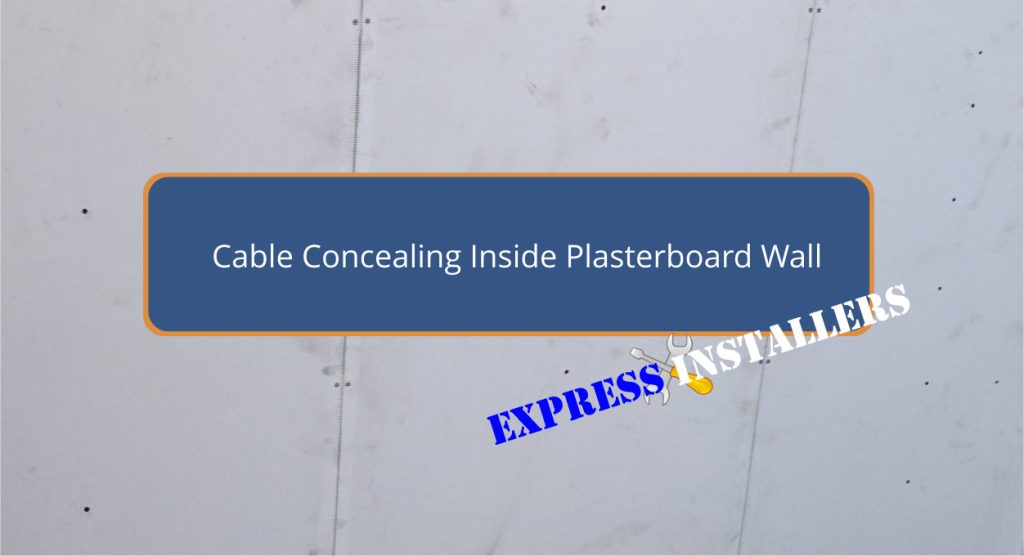
Concealing cables in a plasterboard wall involves careful planning and specific tools to guarantee efficient and safe installation.
Initially, utilise a stud finder to locate studs and avoid electrical wiring. It’s important to turn off power when working near these areas.
Employ a wall chaser to make precise cuts and route cables using PVC trunking or cable sleeves to organise and protect the wires.
Secure cables with speed fix and single gang boxes, and finish with brushed faceplates for a neat appearance.
Proper application of joint compound and sanding ensures the wall is smoothly restored.
Discover more techniques and detailed steps to perfect your cable management in plasterboard walls.
Quick Summary
- Use a cable detector to identify safe paths and avoid hazards before cutting into the plasterboard.
- Employ a wall chaser to make precise cuts for cable routing, ensuring minimal wall damage.
- Install PVC trunking within the cuts to protect and organise the cables, maintaining a neat setup.
- Secure cables using Speed Fix Boxes and ensure a minimum 50mm clearance from the wall surface.
- Cover and patch the routed areas with joint compound, sand smoothly, and prepare for painting to restore wall appearance.
Preparing the Plasterboard Wall
Before installing cables, it is vital to prepare the plasterboard wall by checking for studs and electrical wires using a stud finder to guarantee a safe and secure installation.
Employing stud finder tips, such as calibrating it according to manufacturer’s instructions and using it to detect hidden electrical wires, ensures that the cable installation process does not interfere with existing wiring, thereby preventing potential hazards.
Safety precautions are paramount; always turn off the power supply when working near electrical circuits to avoid shock risks.
Additionally, removing any debris from the work area is essential to avoid accidents and to keep the environment clean and safe for conducting precise cuts and installations in the plasterboard.
Tools and Materials Needed
A complete set of tools and materials is crucial for the effective concealment of cables within plasterboard walls.
To guarantee proper cable management and adherence to safe installation techniques, start by using a cable detector to identify safe routing paths, avoiding electrical hazards.
Employ a wall chaser for precise cuts and a conduit to protect wires, enhancing safety and organisation.
Additionally, PVC trunking and cable sleeves are indispensable for organising and protecting cables efficiently.
For secure installations, speed fix boxes and single gang boxes are recommended. Incorporate brushed faceplates and brush plates to neatly manage cable entry points.
Cutting and Routing Techniques
To efficiently conceal cables within plasterboard walls, begin by using a wall chaser or masonry wall saw to precisely cut a channel for cable routing.
This cutting technique guarantees that the path for the cables is clean and straight, facilitating a more organised installation.
When planning the cuts, it is crucial to direct them vertically or horizontally towards the socket outlets, adhering to safety and compliance standards.
Further, cutting and routing techniques must take into account the protection of both cables and walls. Utilising conduits secures the cables and minimises potential damage.
This approach not only maintains the structural integrity of the wall but also enhances the safety of the electrical setup.
Installing and Securing Cables
Having outlined the cutting and routing techniques, the next step focuses on installing and securing cables within the plasterboard walls.
Proper cable management is vital to maintain safety and functionality.
Here are some key practices to follow:
- Use Speed Fix Boxes: These pboard pattresses help secure cables firmly inside plasterboard walls, preventing movement and potential damage.
- Maintain Safe Distances: Guarantee there is at least a 50mm clearance between the cable surface and the wall surface to comply with safety measures.
- Secure Placement Before Wall Closure: Cap and fix all wiring securely before the final installation of the plasterboard to avoid future issues.
Frequently Asked Questions
How to Hide Cables in Plasterboard Walls?
To hide cables effectively, consider utilising cable sleeves and decorative covers to seamlessly blend wiring with your room’s aesthetic. These solutions provide both protection and concealment for cables within any setting.
Where Does a Cable Have to Be Concealed in Plasterboard?
When concealing a cable inside plasterboard, it should adhere to installation standards to guarantee cable protection, safety, and accessibility. Proper placement minimises risks and facilitates future maintenance or modifications as needed.
Can You Run Cables Behind Plasterboard?
Yes, cables can be run behind plasterboard using appropriate installation techniques that comply with safety regulations, such as using protective conduits and ensuring power sources are disabled during the installation process.
How Do You Run a Cable Through an Interior Wall?
To run a cable through an interior wall, employ cable routing techniques, ensuring wall scanning safety to avoid electrical wiring or pipes. Use tools like a fish tape for guiding cables through drilled pathways.
Conclusion
To sum up, effectively concealing cables within a plasterboard wall requires meticulous preparation, appropriate tools, and precise techniques.
Ensuring the structural integrity of the wall while cutting and routing is paramount.
Proper installation and securing of cables minimise future accessibility issues and maintain functionality.
This method not only enhances safety but also contributes to a cleaner, more organised environment.
